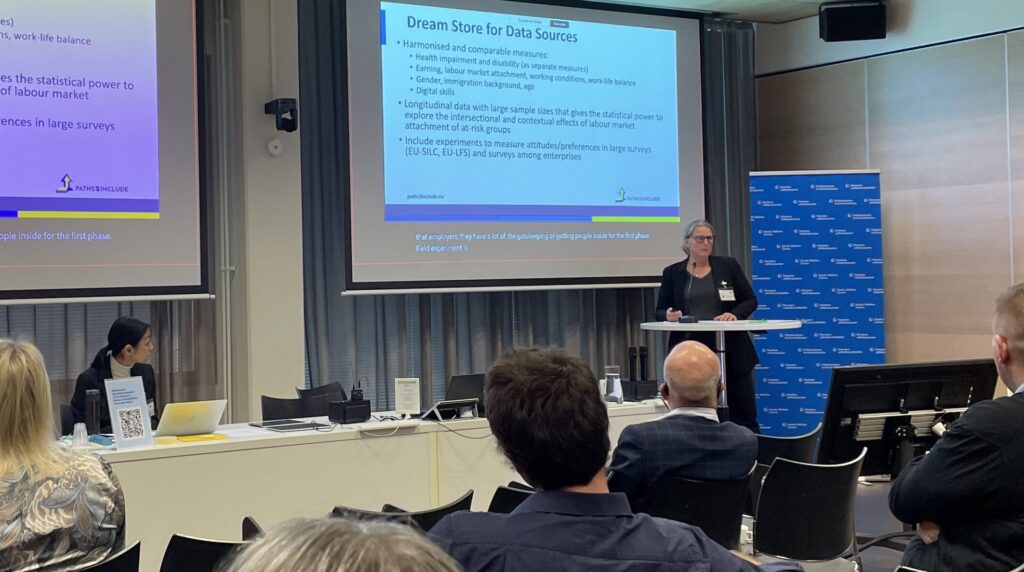More statistics on persons with disabilities in the labour market needed
Handicap
24 okt 2025
We need better statistics on the situation of persons with disabilities in the labour market. Nordic experts and authority representatives met in Helsinki to discuss how this could be achieved.
Persons with disabilities have the right to work on equal terms, according to the UN Convention on the Rights of Persons with Disabilities, CRPD. All the Nordic countries have ratified the convention, and must regularly report to the UN on how the convention is implemented.
For the right to work to become a reality, reliable statistics and data on employment rates, working conditions, and labour market barriers are needed. Nordic researchers, statistics experts and authority representatives gathered in Helsinki on 2–3 October to discuss statistics and quantitative research on the situation of persons with disabilities in the labour market.
Comparable Nordic data needed
An important theme was the possibility of obtaining comparable data between the Nordic countries and producing data that shows the barriers faced by persons with disabilities in working life.
– Comparable data and reliable statistics are crucial for monitoring developments over time and across countries. Without common measures and definitions, it becomes difficult to see what is actually improving – and where challenges remain, says Lars Lindberg, Senior Adviser at the Nordic Welfare Centre, who organised the seminar.
Statistics provide the foundation for informed decision-making.
– Reliable statistics ensure that the rights of persons with disabilities are truly realised in practice, as well as for identifying what we can learn from each other in the Nordic region, says Lars Lindberg.
Challenges with comparable statistics
The comparable statistics available today are based on surveys conducted by the European statistics agency, Eurostat. The statistics differ significantly between countries at the moment, for example when comparing the disability employment gap. The gap is the difference between the employment rates of persons aged 20–64 with and without disabilities. This gap varies widely – not only because the situation differs between countries, but also due to differences in survey questions, employment measures, and definitions of disability.
Several factors make it hard to collect representative data on persons with disabilities. Large groups are often left out for a number of reasons: lack of accessibility, data collection not allowed in housing units, or immigrants with disabilities who avoid contact with authorities, to name a few.
The samples are often small, especially when data is disaggregated. This is even the case with larger European surveys, such as EU-SILC and EU-LFS (see below).

– When combining multiple characteristics – and we don’t need to combine many – such as being a woman and having a disability, the number of responses is often too small for meaningful analysis, explains Elisabeth Ugreninov, Associate Professor at Oslo Metropolitan University.
The statistics on persons with disabilities would benefit from harmonised and comparable measures on for example earnings, labour market attachment, working conditions, gender, immigration background, and age.
Data from longer periods of time are also crucial when we want to study changes over time.
– Longitudinal data with large sample sizes gives the statistical power to explore the intersectional and contextual effects of labour market attachment among at-risk groups. As it is now, it’s very difficult to use the longitudinal design, Elisabeth Ugreninov says.
The benefit of good data
Dan-Olof Rooth, Professor at Stockholm University, showed using American labor market statistics that the opportunity to work remotely during the COVID-19 pandemic had led to a significant improvement in the employment situation for persons with disabilities, and that this improvement has continued even after the pandemic.
Obtaining such data requires a stable definition of disability and a high participation rate in surveys. When attempts were made to compare these results internationally, it was found that data from many European countries were not sufficient to follow individuals over time.
Data to explain barriers and complex situations

It was also emphazised that other forms of data are needed. Stefan Hardonk, Professor at the University of Iceland, says that statistics must focus on inclusion, which means that the labour market itself must change. Inclusion is a process that is not just about ticking boxes (for example, that a person has obtained a job), but it requires new types of indicators that also capture the social barriers described in the CRPD.
– We would like to see more supportive and complementary information and data to be able to explain the complex situations of persons with disabilities, Professor Hisayo Katsui from the University of Helsinki says.
While data and numbers do not give the whole picture, Hisayo Katsui underlines that statistics are needed for several target groups.
– It is good for the general public to see the direction in which we are going. Statistics also help decision makers to grasp this very complex situation, says Hisayo Katsui.
More Nordic cooperation needed
Professor Hisayo Katsui, who moderated the seminar, sees many opportunities for cooperation.
– I think the Nordic countries have been doing a lot of work already so far. But collaboration would help us to notice our shortcomings and then learn from good experiences and practices in the neighbouring countries.
The seminar highlighted the importance of collecting relevant data, disaggregating data, and understanding the contexts behind the numbers. In several Nordic countries, statistical authorities are carrying out development projects to make better use of register data to monitor the situation of persons with disabilities. In the long term, this may improve access to statistics.
The Nomesco-Nososco database and the Nordic Statistics database were presented at the seminar and the aim is to include more indicators covering persons with disabilities in the database. At moment the only disability related indicator is Activity limitations. The participants saw possibilities for more cooperation with the existing databases.
Source: Nordic statistics database, LABO14. The figure displays unemployment rate by reporting country and level of activity limitation.
Facts: EU surveys
EU-SILC (European Union Statistics on Income and Living Conditions)
An annual survey that collects comparable data on income, poverty, social exclusion, and living conditions across EU member states. It provides key indicators for monitoring social cohesion and inequality in Europe.
EU-LFS (European Union Labour Force Survey)
A large quarterly household survey that gathers information on employment, unemployment, and labour market participation in the EU. It is the main source of official EU labour market statistics.
